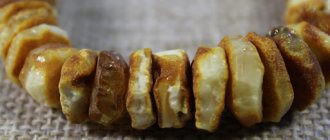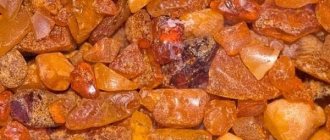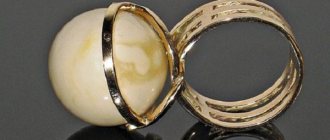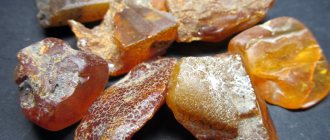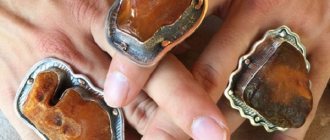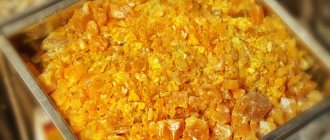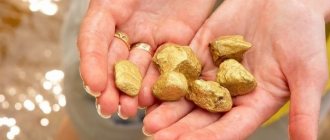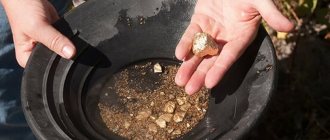- Amber deposits in history
- The largest amber deposit in the world
- Amber deposits in Ukraine
- Features of Ukrainian gems
- How is amber mined in Ukraine?
- Russian amber pools
- Primorsko-Palmnikenskoye field
- North Siberian deposit
- Far Eastern cabochons
- Amber in America
Solar gems have become popular not only because of their beauty and ease of processing, but also because of their availability. Already in the Paleolithic era, people found precious stones on the banks of reservoirs, near swamps and in forests, from which wonderful jewelry and talismans were made. Over time, methods for detecting cabochons improved and craftsmen learned to accurately identify rich sources of hardened resin and weed out scarce ones. And our article will share their secrets with you!
Amber deposits in history
In ancient times, the arsenal of methods and techniques that made it possible to find and extract gems was quite limited - which means that people could only develop superficial, rapidly depleting deposits. Due to the small quantity of precious stones, merchants kept the names of their suppliers and the places where they met with them in the strictest confidence. Often, the leaders of the caravans deliberately chose the wrong road, and the captains ran the ship aground just to deceive the spies and lead them astray from the path to the treasured lands. In addition, cunning traders deliberately exaggerated the difficulties that they had to face when delivering hardened resin, because this immediately increased its cost!
Therefore, a reliable map of amber deposits was a real treasure. The first such indexes began to be compiled by the inhabitants of Assyria and Phenicia (states on the eastern coast of the Mediterranean Sea, which existed in the 16th-8th centuries BC). According to them, enterprising brave men went for solar gems to “the countries above which the North Star stands at the zenith.” Scientists believe that they acquired precious stones from the barbarians who inhabited Jutland (a small peninsula separating the Baltic and North Seas).
Amber deposits in the Kaliningrad region
But already in the early Iron Age (about 1000 BC) this deposit was depleted. According to Pliny the Elder (an ancient Roman polymath writer who lived in 24-79), the new source of amber was the island of Austeravia and the surrounding lands - now about. Ameland and the province of Friesland (Netherlands). Probably, there were gold cabochons in Scythia - the writings of Herodotus indicate that nomads traded with the Greeks, offering them not only grain, furs and honey, but also precious stones that shone like the Sun.
The Eastern and Baltic Slavs also mined gems, and it was on the territory of the latter that one of the greatest deposits, nicknamed the Amber Coast, was discovered. It included the regions of the Curonian Spit and Palanga (Lithuania), Sarnat and Lubanskaya Lowland (Latvia), northwestern Poland and the area near Kaliningrad (Russia). In the Middle Ages and Modern times, people simply picked up solidified resin at the edge of the tide and fished it out of the water when the surf and winter storms lifted floating cabochons from the bottom. According to the most conservative estimates, the waves carried up to 40 tons of precious stones per year!
What is the value of amber
Amber began to be valued and traded by people around 3000 BC. Amber trade routes were well developed in the Bronze Age and remained an important trade right until medieval times. If you are interested in learning about this, we recommend reading our article “The Great Amber Road”. Here we will cite only one fact: Pliny the Elder, who lived in Ancient Rome, wrote: “Among luxury, this product is valued so highly that an amber figurine, no matter how small it may be, costs much more than people (slaves) in the prime of life.”
Over the centuries and to this day, amber remains a very popular natural stone and is used to make jewelry, jewelry and other luxury items. Tens of millions of people around the world wear magnificent jewelry and products made from the solar mineral every day. Everyone does this for different reasons: some simply like amber, while others want to take from it certain magical, beneficial and healing properties that it possesses.
The largest amber deposit in the world
Now that technologies for recognizing and extracting sparkling gems are constantly improving, people are finding more and more varieties of hardened resin . If previously only those collected on the Baltic coast were considered real cabochons, now this category includes any nuggets older than 1 million years (younger ones are called copals and, because of their softness, are used mainly for industrial purposes). Thanks to this, unusual colors and textures of precious stones were discovered, and inclusions from them helped to learn a lot about the flora, fauna and even climate of previous eras.
Researchers have data on over 200 deposits, and here are some of the most famous deposits:
- The Saxon-Anthal quarry (Germany) is located near the city of Bitterfeld. Amber was formed from it 22 million years BC. e. and does not have a weathering crust. From 1975 to 1990, approximately 400 tons of gems were mined, and then the mine was flooded;
- Cabochons from the Baltic region have already been mentioned above. In modern conditions, these include hardened resin from Norway, Denmark, Sweden, the Frisian Islands, Estonia, Latvia, Lithuania and Poland. Gemstones from these regions are very beautiful and durable, as they arose from the pure resin of the Pinus Succinifera pine tree between 100 and 25 million years ago. There are also deposits in the Czech Republic, Slovakia, France and Switzerland, but there is so little amber in them that its development will not pay off;
- They also successfully search for solar gems in England, in the coastal counties of Kent, Norfolk, Suffolk and Essex. Most likely, the cabochons were brought there by the North Sea current;
- gemstones from Sicily (simetites) are famous for their rich blue, olive, reddish-violet hues. They were formed from the resin of tropical angiosperms, so such gems have a low content of succinic acid, but a lot of iron;
Amber mining
- The Romanian (Carpathian) deposit gives people magnificent rumenites, also known as black amber. But in the light it is clear that in reality these cabochons shimmer with deep crimson, indigo, and brown tones. This color is provided by impurities of sulfur and iron;
- African gemstones are mined in Tanzania and Lebanon. The raw material for them was the gum of agathis trees that grew in the Lower Cretaceous period (135-100.5 million years BC). The gems contain inclusions from those times - for example, an Archeopteryx feather;
- Japanese cabochons lie next to layers of brown coal. Their number is small, but this is compensated by an interesting color - striped, like agate or feldspar. The age of the frozen resin is from 120 to 85 million years;
- where to look for amber in Asia? It is found in eastern China, off the coast of Indonesia and on the island of Kalimantan (Borneo), and the largest deposit is in Myanmar (Burma). Burmites are one of the oldest gemstones (105-97 million years old), thanks to which they contain such extraordinary inclusions as the feathered tail of a dinosaur, the ancestor of modern lizards and the chick of Enantiornis. But now these reserves are almost gone - prospectors extract only 10-500 kg of gems per year;
- deposits on the island of Haiti, where the Dominican Republic and the US state of the same name are located, are the source of “opal” cabochons, shimmering with bluish, emerald, and lilac highlights. And under the influence of ultraviolet light, amber begins to emit a phosphorescent glow! Precious stones appeared from the resin of the fossil tree Hymenaea protera, which grew 40 million years ago on the slopes of the Cordillera, so clusters of gems are located at an altitude of 500 m - 1.2 km in quickly crumbling sandstone;
On the shores of the Baltic Sea
- Where does amber come from in Canada? Deposits of the so-called Cedarite ambrite is found near the cities of Alberta, Grassy Lake and Medicine Hat, and near lakes Cedar and Manitoba there are secondary deposits, that is, the gemstones were brought there by the waves of ancient seas. Such nuggets are very important for science, because they often contain unique inclusions - ants, mites, pollen and spores of prehistoric plants;
- in Mexico, hardened resin was recently discovered in the state of Chiapas;
- cabochons called retinites are even found in southeast and southwest Greenland. Their age is about 100 million years, and butterflies, ants, mosquitoes and tropical flower petals enclosed inside amber indicate that dense forests once grew in place of the ice fields;
- In New Zealand, both true gems and copals are mined from the resin of kauri and agathis trees (the latter are most often used for making varnish).
What is amber and what are its properties?
Amber is found in places where many coniferous trees previously grew, and this is not surprising, because amber is nothing more than their fossilized resin. However, in this precious world there are exceptions - blue Dominican amber, which was formed from larch resin. On different continents and even in different nationalities, the name of the stone was different, but the word “amber” itself was presumably borrowed from the Lithuanian language. Poets also attribute many lyrical comparisons to the stone, for example, “tears of the sea” or “gift of the sun.”
The properties of amber are not quite typical for a semi-precious mineral.
First of all, it lacks the ability to form crystals and is essentially a framework amorphous polymer. It is easy to process and polish, for which it is very loved by craftsmen who work with minerals. It does not refract light, as many other semi-precious stones do, and does not change its color when light hits it from a different angle. What is noteworthy is that this mineral is quite flammable; a flame of a match is enough for it to ignite and begin to release a pleasant aroma. When rubbed, amber becomes electrified, and when exposed to air it reacts with oxygen - it oxidizes, becoming less bright over time and becoming friable.
Amber deposits in Ukraine
The fact that there are deposits of precious stones in the north-west of the country has been known for a very long time. There were so many cabochons that in Kievan Rus amber was used both to create accessories and to simply heat stoves - when burned, pieces of frozen resin released a pleasant warmth and fragrant aroma that purified the air and prevented diseases.
Map of amber deposits in Ukraine
Ways to distinguish natural stone from fake
In order to distinguish a natural stone from a fake, you should first remember its properties. Amber ignites with a simple match and releases a pleasant woody aroma, so you can lightly light the stone and see its reaction. Well, if such experiments on a gemstone are too much, then you can use other methods, for example:
- The weight of amber is very small, products made from it are very light, almost weightless, while jewelry made from surrogates will have all the tangible weight.
- Pay attention to the structure of the stone - it cannot be homogeneous, because amber is a fossilized resin that has been formed for a long time.
- Amber has a negative electrical charge, so if you rub it on wool, it will begin to attract pieces of paper and hair.
- You can try scratching the amber with a needle. A real stone will chip; a plastic surrogate will come off in thin, uniform chips.
- The stone is not afraid of most household solvents, so a drop of alcohol or acetone will not harm it, but it will leave a cloudy stain on the plastic.
- Amber in salt water will float to the surface, so you can check it this way if the stone does not have a setting.
To be sure, it is better to do several tests to make sure that this is a real semi-precious stone. It is best to buy products in official jewelry stores, and also ask sellers for confirmation of the authenticity of the stone, which should also indicate where in the world the amber used in a particular piece of jewelry was mined.
Features of Ukrainian gems
This amber pool is called Rivne or Klesovo-Dubrovitsky. Its total area covers more than 5 km2, stretching along the Volyn, Rivne, Zhytomyr and Kyiv regions. The reserves of precious stones are very large - there are 250-1000 g of cabochons per cubic meter of land. Their volume varies from 1 to 10-15 cm3, and sometimes there are real giants - nuggets over 20 cm3, weighing 1-3 kg!
According to the physical and chemical characteristics of Polesie gems, formed 40 million years BC. e., are almost no different from the Baltic - they have the same high content of useful succinic acid and oil.
But the color of domestic hardened resin is much richer - from the usual yellow-orange to amazing olive-greenish, purple and black tones.
Amber mining in Ukraine
Amber plant today
Throughout its history, the Kaliningrad Amber Plant has consistently increased production and expanded its product range - from mass-produced amber products to dielectric insulators, varnishes, enamel paints, as well as components for the chemical industry. In 2014, the enterprise became part of the Rostec State Corporation, and already in 2015, KYAK’s revenue growth amounted to 30%. New workshops and production areas were launched, and modern equipment was installed. An important component of growth was a new model of interaction with counterparties, including control over unscrupulous resellers. Technologies are changing to be more environmentally friendly and more gentle with respect to fragile amber. Exports are developing, major contracts have been signed with China.
A unique enterprise attracts the attention of tourists. In 2022, the plant launched an excursion project “A Day with a Sunstone”, which offers an opportunity to get acquainted with the history of amber mining. A multimedia exhibition hall and an observation deck are open to tourists. The project became a laureate of the All-Russian Tourism Award “Route of the Year 2018” in the category “Best route to an existing production.”
How is amber mined in Ukraine?
Until the 1990s. development was carried out unsystematically and artisanally, reaching the state level only in 1993. An important property of the local deposit is its shallow occurrence (on average, precious stones are located 3-10 m from the surface, or even immediately under the turf layer). This means that removing cabochons requires virtually no effort - even a directed stream of water, eroding soft soil, is enough for this. Unfortunately, such availability tempts illegal miners: 120-300 tons of hardened resin are sold on the black market per year, while the official production volume is 3-5 tons. This not only brings huge losses to Ukraine, but also provokes an environmental disaster - the destruction of natural biocenoses and landscapes.
Nevertheless, Polesie gems remain one of the most sought after in the world due to their durability, original palette and purity of shades. And inclusions in precious stones made it possible to discover and describe several new species of insects, scorpions, nematodes and polychaete worms.
What is the Palmnikensky section
So, next, let's look at how amber is mined in Kaliningrad and where exactly the development is carried out. The total area of deposits of this gem in the Baltic Sea in Russia is more than 300 km2. The largest not only in the Russian Federation, but also in the world at the moment is the Palmnikenskoye field located near the village of Yantarny. About 70% of all amber deposits on the planet are concentrated here.
The Palmniken deposit began to be developed industrially in the century before last - in 1872. In all subsequent years, up to 300-800 thousand tons of amber were mined in these places per year. At the moment, the Palmnikenskoye field is mothballed. Development today is carried out at two adjacent sites: Primorsky and Plyazhevoy.
Primorsko-Palmnikenskoye field
It is located on the western coast of the Zemland Peninsula, 40 km northwest of Kaliningrad. Where there is amber is indicated by deposits of the so-called. “blue earth” - greenish-gray clayey sands with an admixture of quartz and glauconite. They lie at a depth of 40-100 m, and the layer thickness is 0.5-15 m. These soils were covered by the sea during the Oligocene (33.9-23.03 years BC) and Miocene (23.03-5. 3 million years BC), but the cabochons hiding there are much older - their age exceeds 50 million years!
Among Kaliningrad gems there is not only valuable succinite. Up to 2% of production comes from gedanite - “rotten stone”, cloudy and brittle. Kaliningrad amber can be round (this means that in ancient times it was rolled by tidal waves) or clawed - with protruding corners and edges. Its size also varies - from tiny grains with a diameter of 5 mm to kilogram giants. And the most massive specimen weighing 12 kg was found in the 19th century.
According to rough estimates, 70-90% of the world's amber is concentrated in this deposit. In 1 m3 of parent rock there is from 0.6 to 2 kg of hardened resin, and almost the same amount of precious stones on the sea shelf that is adjacent to this area. Even though one of the quarries is mothballed, and prospectors annually extract up to 350 tons of cabochons, the reserves will last for a long time.
Amber mining on the ocean shore
Dominican Republic
The island of Hispaniola, which is now divided between the Dominican Republic and Haiti, conceals in its depths reserves of unique mountain amber. The said stone is extracted from deserted areas deep in the Cordillera. We are not talking about industrial mining - small mining teams work here, digging fairly deep mines with primitive tools. The lack of engineers and qualified geologists does not allow the full extraction of amber, so a considerable part of it remains in the ground. There are no official statistics on production volumes, but it is most likely small.
The Dominican gem is unique primarily for its transparency. It is also worth noting the variety of shades. Find instances:
• green; • reddish; • blue; • brown.
In terms of decorative properties, stones are second only to Baltic stones.
North Siberian deposit
Amber-bearing rocks were discovered in the Khatagan depression, in the Urals, in Taimyr and on the northern shore of the Arctic Ocean. M.V. Lomonosov wrote about them: “In Chaya Bay... there are signs of a stone called sea incense.” Solar gems from there are darker than those from the Baltic, and have a thicker weathering crust , since this hardened resin appeared 78-115 million years ago. The number of cabochons is from 0.1 to 0.5 kg per m3.
Industrial development of the deposit is futile - the gems from it are too small and scattered over a very large area. But “black” diggers do not disdain such chances - 1-3 tons of gems are confiscated from them every year.
WHAT TO DO WITH THE PRODUCTION
If you have amber, the best thing to do is make it into a keepsake piece for family members.
- It would be good to use raw amber when making a necklace for a child.
- This jewelry can be worn by a baby from 3 months, but under the supervision of adults, as well as subject to safety rules. It is believed that the solar mineral calms the nervous system and helps teeth erupt, but you should not let your child chew on it.
- When making or purchasing such jewelry, you should take into account that the stones must be round in shape so as not to harm the baby, the rope is strong, and it is better to tie knots between each gem.
If you find a piece of amber weighing 5 kg
If you find a large amber weighing 5 kg or more, know that it is considered a precious stone and belongs to the state, so it is better not to take such a find, but to report it to the police.
If you took a stone, take it to the police yourself in order to avoid criminal prosecution: and your conscience will be clear, like transparent amber. If you are not too lazy to make the journey to the village of Yantarny, you can hand over the gem to the plant.
Evaluation of the find
To evaluate amber, you need to consider the following points:
- Mineral weight. Amber crumbs have a low price. It also takes into account the size of the particles that make up the stone: the larger they are, the higher the cost.
- Gem shape. Gems that are close to the correct geometric configuration are valued higher.
- Opaque stones are more expensive, especially lemon or milky shades.
- The presence of bubbles adds to the price of the mineral.
- Amber with pieces of plants or insects inside are 5 times more expensive than ordinary ones.
- Minerals with lizards or scorpions frozen in them are very expensive and rare.
Amber with pieces of plants
How to export amber by plane
When transporting amber by plane, you should keep in mind: according to Customs Legislation, minerals intended for personal use can be freely exported. The weight of the stones should not exceed 50 kg per person, and the cost of the cargo cannot exceed 1.5 thousand euros. Naturally, the price of gems must be confirmed by a financial document.
We recommend: Frozen in Time | AMBER INCLUSIONS
Far Eastern cabochons
When listing places where amber can be found, few people remember the Russian Pacific coast. But there is frozen resin here too - the deposit covers Southern Sakhalin, Pechora, Kamchatka. Evenks, Udeges and Nanais traded precious stones from there. It is interesting that this deposit belongs to the primary ones - the gems arose right there, and were not brought by screes, glaciers or water. Radiological analysis has established that cabochons were formed 65-110 million years BC. e.
Catching amber stone
Modern methods
The use of modern methods depends on the depth of deposits, location and other features. Among them are:
- hydromechanical;
- underground;
- nautical.
The hydromechanical method is used for open-pit mining. For this purpose, special equipment is used.
The underground method is the development of mines, but is considered unprofitable, and therefore is rarely used. For the marine mining method, dredgers are used to remove the top layer of sand, after which the minerals are cleaned and processed.
Amber in America
Gold stones are found in almost all US states - from Alaska to Texas. The most generous deposit is in Ellsworth County (Kansas), along the bed of the Smoky Hill River. In the first half of the twentieth century. it was discovered by naturalist J. Jelinek (in his honor this frozen resin was called jelinite), but already in 1948 most of the deposit was flooded during the construction of a dam.
Other American sources of solar gems are valuable primarily for scientific research. So, in 1967, a primitive insect was found in a nugget from New Jersey - a “transitional link” between ichneumon wasps and ants. Cabochons from Arkansas harbored more than 900 species of spiders, moths and plants, a gem from Tennessee revealed the first stonefly fossil, and a piece of amber from Alaska contained a mushroom.
Gems from New Mexico contain cypress needles and particles of sequoia wood, and cabochons from Washington contain remains of cedar. The stones from Wyoming are unusual - at first they were mistaken for hardened resin, but in the late 1970s. geologist Steve Levin realized that the brittle, reddish-yellow crystals were the result of an explosion at a uranium mine in Jeffrey City.
Residents of the United States value their amber very much. The places where it is found are declared a national treasure; exporting nuggets weighing over 500 g from the country is strictly prohibited, and illegal excavations are punishable by imprisonment and a huge fine.
